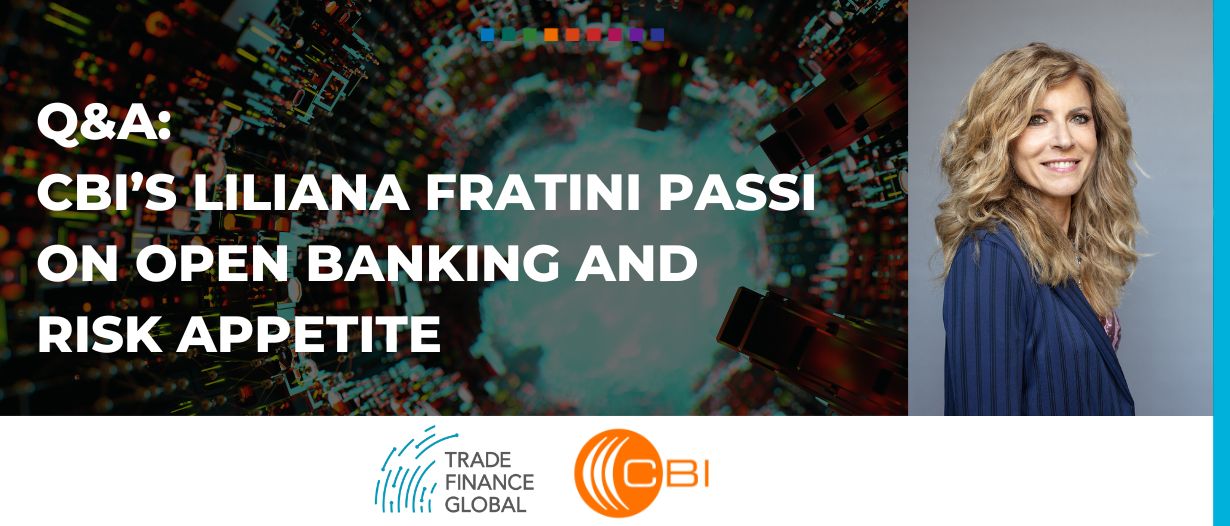Estimated reading time: 6 minutes
The world of open banking is seeing a shift as a result of changing customer demands.
Market uncertainty, following COVID-19, the Russia-Ukraine conflict, and rising inflation rates, has significantly impacted risk appetite and businesses’ approaches toward financial services.
Trade Finance Global (TFG) are delighted to have had the opportunity to speak with Liliana Fratini Passi, Managing Director, CBI, for further insight into the situation.
1. Introduction: who are you, where are you from, and what do you do?
My name is Liliana Fratini Passi. I am the managing director of CBI, a company with more than 400 banks and financial intermediaries as members and customers.
It can be identified as an industry utility that serves financial institutions and European Payment Service Providers helping them to respond more efficiently to the numerous market challenges in the digital payments landscape.
In addition, I’m the UN/CEFACT (United Nations Centre for Trade Facilitation and Electronic Business) Vice-Chair of the Pay Section of the International Supply Chain Programme Development Area and liaison Rapporteur of the UNECE to the ISO Technical Committee on Financial Services (ISO TC68).
CBI develops collaborative infrastructures––digital services with a Business-to-Business-to-Customer (B2B2C) perspective––to help its customers in offering their clients (corporates, retails, and public administration) innovative payment and information services.
To this effect, it can be stated that CBI acts as a fintech with 30 years of history, offering innovative open banking and open finance solutions tailored to corporates, banks, payment services, and other fintechs.
2. What are the major challenges that you see Europe facing in light of the macroeconomic climate? Is Italy facing these same challenges?
In a period of market turbulence, especially following the fallout of COVID-19 and the Ukraine-Russia conflict, it is evident that restoring business activity and consumer confidence is a challenging but necessary prospect.
What has become evident so far is how digitalisation is reshaping the financial market, including changes in demand and supply for financial products and services.
COVID-19 can be considered a catalyst for this enormous change, especially in Europe, pushing financial institutions to increase their investments in innovative technologies and digital payments, alongside developing legislative regulations to strengthen security and transparency.
According to the report on the Status of Implementation of the National Recovery and Resilience Plan, Italy is meeting the timetable and targets set.
To this effect, last month, the European Commission noted that Italy has made sufficient progress in implementing its national plan to receive a second payment from NextGenerationEU.
This step forward represents a unique opportunity for future investments and reforms, leading to better economic and social developments in Italy. This initiative will also help to remove obstacles and market fragmentation, creating more stable, lasting, and sustainable growth for the overall Italian market.
Prior to COVID-19 and various market fluctuations, the Italian financial industry had already launched digital services.
Based on CBI’s experience, collaborative ecosystems are the most efficient and effective method for achieving both compliance and continuous innovation.
3. How does your approach to open banking differ from market to market?
CBI believes that banking as a platform and banking as a service (BaaS), represent two increasingly sought functions in financial product distribution, driven by social change and new digital awareness.
Customers now expect finance to be embedded at the point of need. Open banking represents a secure, efficient, and effective tool for meeting these customer demands.
Approaches towards open banking often vary according to the context. This is particularly evident in the Global Open banking Report written by CBI in collaboration with PwC, where three predominant practices have been identified: prescriptive, market driven, and facilitative.
All these practices are linked to the presence or absence of a defined regulatory framework, and each with their advantages and disadvantages.
The majority of countries follow a prescriptive approach, such as the EU member states, the UK and Australia.
CBI believes that this is the most effective as it obliges players to comply with open banking regulations and provides more clarity on steps to follow towards its adoption. A prescriptive approach also helps market players to plan their actions in a timely and coherent manner.
More particularly, CBI believes that open banking can lead to enhanced direct and indirect revenue opportunities in the short-medium term.
New business opportunities have been unleashed by PSD2. Collaboration among traditional banks and Fintech could allow the development of innovative services with better time-to-market, technical simplifications, and lower investments.

Nevertheless, in the long run, open banking will massively transform how people engage with banks and beyond.
Another common practice is the facilitative approach, which is favoured in Asia, particularly; India, Japan, and Singapore.
These countries are developing innovative services in the open banking and finance field, enabled by local authorities’ initiatives (e.g., in India’s Demonetisation Policy, Aadhaar and Unified Payments Interface––UPI).
These policies are just examples of initiatives that boosted digitalisation in India and enabled open banking across financial institutions (FIs) and markets.
Finally, the market driven approach is adopted in USA and China. However, recently in the USA, local authorities are evaluating to outline regulatory addresses.
The European Financial Community, through collaborative initiatives, such as CBI, plays a significant role in the development and standardisation of Application Programming Interfaces (API).
This will prevent similar APIs from simplifying the relationship between banks and businesses, following three-tiered APIs: regulatory APIs (PSD2 for Europe), “Beyond PSD2” banking APIs, and third-party APIs.
CBI, for instance has already identified use cases and basic services to allow banks to play an important role in the open finance field. Examples include, international account aggregation services, IBAN checks, services to support the know your customer (KYC) process, financial management and credit scoring services, and the development of a new distribution model, which sees the collaboration between multiple players in the market chain, including the public administration.
CBI is developing an innovation ecosystem which aims to facilitate the definition of new value-added services.
4. How heavily does the risk environment play into these differences?
The financial services industry has seen profound technology-led changes over the past years.
Therefore, this industry is experiencing a sort of revolution due to the impact of new paradigms based on open models such as open banking, open finance, and open data based on API technology.
Customers’ changing needs/and demands are leading financial institutions to modernise their business models and products.
Since more financial institutions are considering open banking practices, regulations are being pushed worldwide to embrace innovation, while retaining solid risk management and governance principles.
The European region has also seen an explosion of fintechs in recent years, all offering similar products to a traditional bank.
Like many other institutions and corporates, CBI has carefully analysed the overall market environment as the volume of these niche start-ups increases exponentially.
In relation to the European Commission actions, it is evident that major initiatives have been developing, such as the Digital Finance Package, the Open Finance Consultation, and the EU Data Act. These efforts all have a common goal of enhancing services and business models based on data sharing.
Therefore, CBI fervently believes that in light of this new market scenario, incumbents have to create new ways of collaborating and partnering to develop innovative products that improve user experience.

































